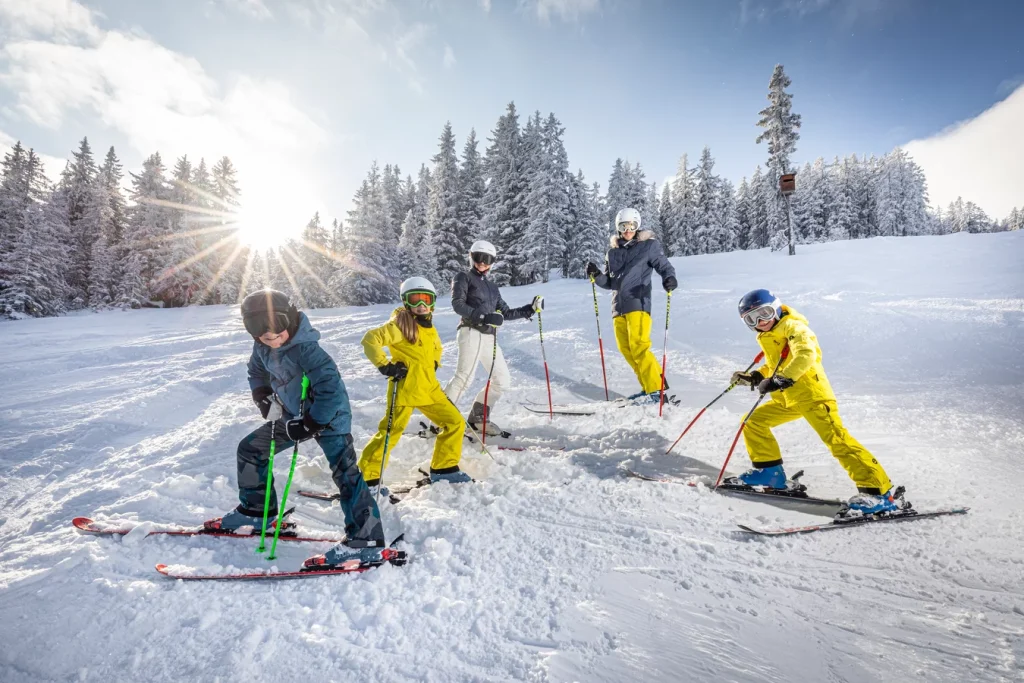Here is a beginners guide to Skiing on a budget. Ski resorts can be daunting, and they don’t have the reputation for being the most affordable — particularly for total beginners, who are usually stumped by all the beginners costs, investing in clunky kit they might not even want to keep.
But here are some ways to go off-piste when it comes to spending and have a carefree ski. Skiing is all about your body telling the skis what to do through movements. So, it’s important to focus on what your body is doing, and how that affects the skis. Begin by focusing on one movement at a time—if you think of too many things at once, your body will stiffen.
For skiing you do need a certain level of skill and stamina
For skiing you do need a certain level of skill and stamina: Stance and Balance: requires you to have strong elsg and endure the semi squat position as Skiers face forward and crouch down, which can make it easier to maintain balance and control, especially for beginners.

3 things you should know before you go skiing:
Before you go and start booking, here are 3 things you should know before you go skiing.
1 – Get some dry ski slope lessons in advance – it will help, with basic skiing but also it will prepare your muscles for a different kind of intensity. An added advantage, you can test your coats and goggles to ensure they are comfortable before you go.
2. – Get the right equipment – once you have purchased your equipment, make sure it fits, getting replacements is expensive and difficult. You need to be comfortable or you will suffer.
3. – Get a bit fitter – Do some exercising at least a few weeks before you go.
A note to remember, always wear sunscreen, and goggles or sunglasses, even on cloudy days. Even in the winter, UV rays are reflected from the snow surface. Cold temperatures increase the likelihood of frostbite. Dress warm and keep an eye on exposed skin.
The top of the ski slopes are generally warmer than the bottom, especially if they are above the clouds and on a sunny day, you can embrace the sun in the snow, in a T shirt.
Skiing on a budget
Avoid the chalet. Hostels, BnBs and more basic guest houses are the way to go to swerve some costs. There’s no need for excessive luxury when you’re spending all day hitting the slopes. You need to make sure you know the breakfast times and dinner times, because often you will not get room service in the middle of the night.
Stock up with snacks. Skiing hostels and places are usually, in remote places, and the weather will be cold and the snow will make it hard to get around. So it is best to get some snacks for your room and energy bars that you can take with you in the ski slopes. We also recommend a flask for hot water so you can enjoy the serenely beautiful moments at the tops of the hills with a tea or coffee.
Plan how many days you will be skiing. Skiing for beginners can be intense, shin splints and tired legs are common until your body adapts to the new intensity it will be put under, as you will use muscles that you don’t usually use. So unless you’re already fit, you may need a days rest between skiing.
Take advantage of flexible ski passes. In Ski amadé or the skii lovers, groups of resorts usually include multiple entrances to different ski slopes. Like in Flachau, which is in Austria a multipass will cover you for 25 sites including 270 ski lifts, so you can travel without stumping up extra. Plus if a week-long ski pass isn’t a realistic spend, you can opt for a few days or just one.
Use public transport. Ski shuttle buses take you between resorts are usually for free, in some cases you may need to book in advance or buy a travel pass as well but they are very accommodating.
Get your gear for cheap(ish). A winter coat, salopettes, goggles, gloves… buying all the clothing you need quickly becomes a slippery slope. get the right size boots and test they are fitting in advance. Many online community groups let you buy garments second-hand directly from owners, sell once you’re home, or swap if you’ve got the gear but it doesn’t fit.
Hire skis and boots. You can hire skis and boots from resorts if you have luggage restrictions but coats and gloves are essential, that you must get in advance. Comfortable clothing is the key, in this case, substance over style is important.
Skiing is fun and thrilling, but it’s not for everybody. Or even still you may prefer to do it sparingly. Skiing enthusiast usually skii every day. But you don’t have to if you don’t want to, you may like to do it every other day. Perhaps you arrive only to discover the sport isn’t your cup of tea. But thats okay, you can enjoy the views and the cosy chalets.
Some useful FAQ’s
Is skiing safe for beginners?
Skiing and snowboarding have some risks but generally speaking, skiing is often considered less dangerous for beginners. as a rule of thumb … you can always stop by falling into the sides where there snow is deep and soft.
What should a beginner skier know?
As a beginner every skiers needs to know that they can get down any bad bit safely with a side slip. Or stop by falling in the soft snow sides. The Skiis automatically come off and you will learn this in your first lessons.
Do you need to be fit to learn to ski?
You don’t need to be extremely fit but you should do some running and exercises before you go. At least 3/4 weeks worth of training with a mix of leg and endurance training. After all it is a winter sport has to be extremely sporty to be able to ski. A certain level of fitness is required for winter sport.
Can I go skiing without lessons?
The short answer is yes, although we would only recommend this if you have some skiing experience. And you can book a refresher lesson at the slope.


